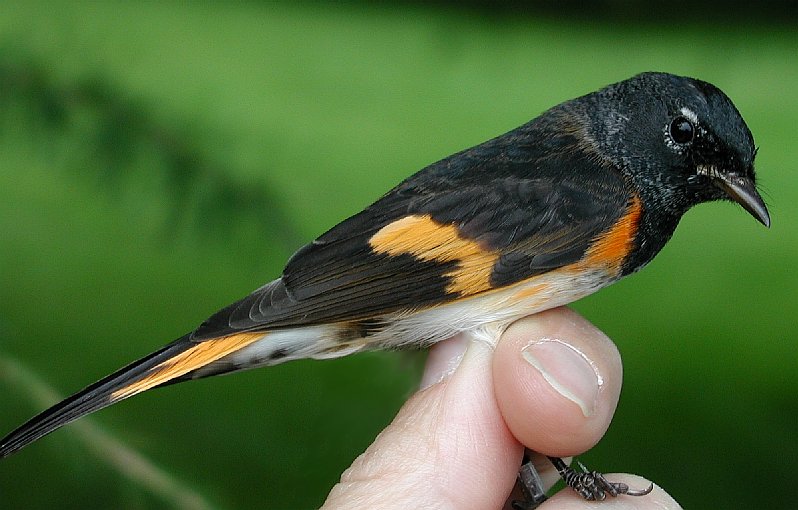
by birdsafepgh

by birdsafepgh
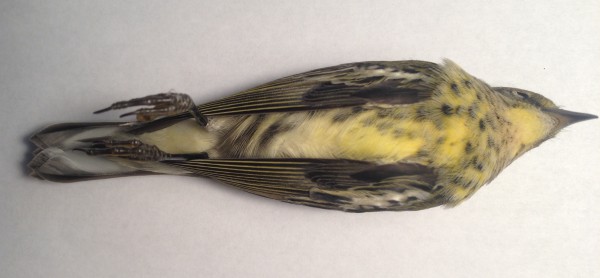
Autumn is the busiest time of year for BirdSafe Pittsburgh monitors, because during fall migration more birds are moving through than during spring. Breeding adults are moving back to their wintering grounds along with all of the birds that were born this year. In fact, many (but definitely not all!) of the birds our monitors find as victims of window strikes are what we call “hatch-year” birds, or birds that were born this summer. This could be due to a number of factors, including the fact that they have never undertaken such a long flight and are forced to refuel in less than ideal locations.
Our BirdSafe Pittsburgh monitors walk the streets of the downtown area early each morning to look for birds that have struck windows. Usually when a bird collides with a window it is killed instantly, but sometimes they survive the initial impact and stand stunned on the sidewalk below the window. Our monitors are able to walk right up to the bird and safely capture it to keep it from being stepped on, run over, or swept up by cleaning crews. All of the live birds are taken to the Animal Rescue League’s Wildlife Center, where they are given a thorough checkup and released if they are OK.
This fall (as of October 7) monitors have found 43 such live birds out of the 103 found so far. Only 3 of these birds escaped capture, but the other 40 were taken to the rehab center. The vast majority of these were released within a day or so of being checked in, and were able to resume their travels south!
Here is a list of birds found in the downtown area so far this season.
Table 1.) Birds found during BirdSafe Pittsburgh monitoring efforts, Sept 1 – Oct 7, 2015. (* denotes that bird was not captured)
| Species | Dead Birds | Stunned Birds | Total |
|---|---|---|---|
| Rock Dove | 2 | 3 | 5 |
| Mourning Dove | 1 | 1 | |
| Ruby-throated Hummingbird | 4 | 4 | |
| Northern Flicker | 1 | 1 | 2 |
| Yellow-bellied Sapsucker | 3 | 4 | 7 |
| Eastern Wood Pewee | 1 | 1 | |
| Blue Jay | 4 | 4 | |
| Brown Creeper | 2 | 2 | |
| House Wren | 1 | 1 | |
| Brown Thrasher | 1 | 1 | |
| Gray Catbird | 2 | 2 | 4 |
| Hermit Thrush | 1 | 1 | |
| Swainson’s Thrush | 1 | 1 | 2 |
| Gray-cheeked Thrush | 1 | 1 | |
| Catharus Sp. (Thrush) | 1 | 1 | |
| European Starling | 2 | 2 | |
| Black and White Warbler | 2 | 1 | 3 |
| Tennessee Warbler | 2 | 4 | 6 |
| Magnolia Warbler | 2 | 1 | 3 |
| Black-throated Green Warbler | 2 | 2 | |
| Cape May Warbler | 1 | 1 | |
| Blackburnian Warbler | 3 | 3 | 6 |
| Bay-breasted Warbler | 1 | 1 | 2 |
| Blackpoll Warbler | 3 | 3 | |
| Ovenbird | 9 | 8 | 17 |
| Common Yellowthroat | 5 | 4 (1*) | 9 |
| Mourning Warbler | 1 | 1 | |
| Connecticut Warbler | 1* | 1 | |
| Hooded Warbler | 1 | 1 | |
| American Redstart | 1 | 1 | |
| Unknown Warbler | 3 | 3 | |
| Lincoln’s Sparrow | 1 | 1 | |
| Unknown Sparrow Spp | 1* | 1 | |
| House Sparrow | 1 | 1 | |
| Unknown Species | 2 | 2 | |
| Grand total | 60 | 43 | 103 |
If you would like more information about how you can get involved in helping us learn more about window collisions in the Pittsburgh area visit this page. You can also follow us on Facebook and Twitter.
by birdsafepgh
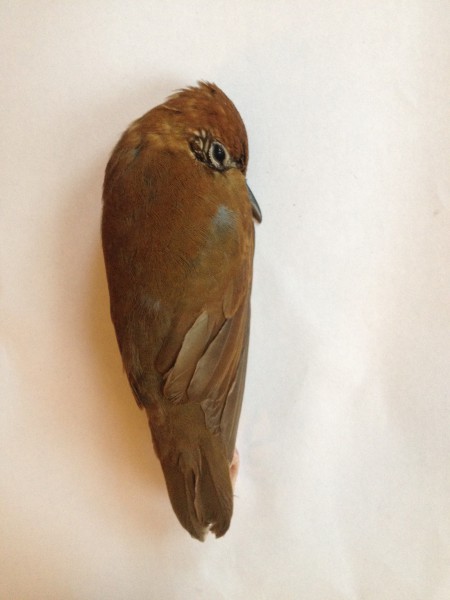
BirdSafe Pittsburgh’s fall 2015 monitoring season begins Tuesday, September 1. To see how to get involved in what we do, visit our volunteer page. The fall migration is much busier than the spring because of the sheer number of birds moving through. All of the birds that were born this summer are starting out on their first migration, and it is during this time that they are especially susceptible to all of the different threats they face, windows included. These juvenile birds add to the breeding migratory birds, dramatically increasing the number of individuals moving south for the winter. To get a sense of the difference in magnitude between the two migratory seasons, let’s take a look at our numbers from the past three seasons.
During the last three seasons of BirdSafe Pittsburgh volunteer monitoring, we found 322 individual birds which suffered from building window collisions. So far we identified 67 different bird species (and one mammal species) collected as either dead or injured with 26 individuals collected by volunteers and as yet unidentified to species by BirdSafe partners.
| Bird Condition | Fall 2014 | Spring 2014 | Spring 2015 | Total |
|---|---|---|---|---|
| Dead | 115 | 52 | 69 | 236 |
| Stunned | 50 | 17 | 19 | 86 |
| Grand Total | 165 | 69 | 88 | 322 |
Table 1 shows that during the fall of 2014, volunteers found more birds than both of our two spring seasons put together! Our volunteer efforts have also increased over the last three seasons, and that likely accounts for the increase in number of individuals found between the two spring seasons. If we are able to recruit more volunteers this fall, we may find and save more birds than we did last fall! (Again, visit our volunteer page to get involved! Send all of your friends to the volunteer page too! We need more volunteers!)
Have you ever wondered what our volunteers find? Breaking down the last 3 seasons data shows that more Ovenbirds, a ground-nesting forest interior bird, have been found than any other species. Relatively high numbers have been found for both White-throated Sparrow, an uncommon breeding bird in PA, and Wood Thrush, another forest interior bird and Neotropical migrant. We found single individuals for 35 species. Some of these included Eastern Whip-poor-will, Canada Warbler and Veery – again all forest interior birds which breed in Pennsylvania. Also of note were 2 Mourning Warblers, 3 Connecticut Warblers, and 3 Gray-cheeked Thrushes, 4 Blackpoll Warblers, and 7 Brown Creepers.
Table 2.) BirdSafe Pittsburgh bird collisions by species (2014-2015), showing species with > 10 collected.
| Species | Total (3 Seasons) |
|---|---|
| Ovenbird | 38 |
| White-throated Sparrow | 23 |
| Wood Thrush | 23 |
| Gray Catbird | 17 |
| Yellow-bellied Sapsucker | 16 |
| House Sparrow | 15 |
| Common Yellowthroat | 14 |
| American Robin | 12 |
| Unknown Warbler Species | 11 |
Please consider taking part in the fall monitoring, and please let everyone you know about what we are doing to make Pittsburgh a more bird-friendly and ultimately more livable city for our feathered friends!
Here is a full list of all birds found by volunteers during the last three monitoring season:
| Table 3. BirdSafe Pittsburgh window collisions by species and season, 2014-2015. (order follows AOU) | ||||
| Species | Fall 2014 | Spring 2014 | Spring 2015 | Total |
| American Woodcock | 1 | 1 | ||
| Gull Sp | 1 | 1 | ||
| Rock Pigeon | 4 | 4 | ||
| Mourning Dove | 1 | 3 | 4 | |
| Black-billed Cuckoo | 1 | 1 | ||
| Yellow-billed Cuckoo | 1 | 2 | 3 | |
| Eastern Whip-poor-will | 1 | 1 | ||
| Ruby-throated hummingbird | 3 | 2 | 1 | 6 |
| Hairy Woodpecker | 1 | 1 | ||
| Yellow-bellied Sapsucker | 10 | 6 | 16 | |
| Northern Flicker | 1 | 1 | 3 | 5 |
| Eastern Wood Pewee | 1 | 1 | ||
| Empidonax Sp | 1 | 1 | ||
| White-eyed Vireo | 1 | 1 | ||
| Red-eyed Vireo | 1 | 1 | ||
| Blue Jay | 1 | 1 | 2 | |
| Northern Rough-winged Swallow | 1 | 1 | ||
| Carolina Chickadee | 2 | 2 | ||
| Brown Creeper | 6 | 1 | 7 | |
| Tufted Titmouse | 1 | 1 | ||
| White-breasted Nuthatch | 1 | 2 | 3 | |
| House Wren | 1 | 1 | ||
| Winter Wren | 1 | 1 | ||
| Golden-crowned Kinglet | 1 | 1 | 2 | |
| Ruby-crowned Kinglet | 1 | 1 | 2 | |
| Wood Thrush | 2 | 9 | 12 | 23 |
| Swainson’s Thrush | 3 | 3 | ||
| Veery | 1 | 1 | ||
| Gray-cheeked Thrush | 3 | 3 | ||
| American Robin | 2 | 2 | 8 | 12 |
| Gray Catbird | 6 | 2 | 9 | 17 |
| Brown Thrasher | 4 | 4 | ||
| Cedar Waxwing | 1 | 3 | 1 | 5 |
| European Starling | 2 | 2 | ||
| Yellow Warbler | 1 | 1 | 2 | 4 |
| Chestnut-sided Warbler | 1 | 1 | ||
| Magnolia Warbler | 3 | 2 | 5 | |
| Black-throated Green Warbler | 2 | 1 | 3 | |
| Yellow-rumped Warbler (Myrtle) | 3 | 1 | 4 | |
| Pine Warbler | 1 | 1 | ||
| Blackpoll Warbler | 4 | 4 | ||
| Bay-breasted Warbler | 1 | 1 | ||
| Yellow-throated Warbler | 1 | 1 | ||
| Tennessee Warbler | 8 | 8 | ||
| Nashville Warbler | 2 | 2 | ||
| Black and White Warbler | 1 | 1 | ||
| American Redstart | 1 | 1 | ||
| Common Yellowthroat | 9 | 2 | 3 | 14 |
| Mourning Warbler | 2 | 2 | ||
| Connecticut Warbler | 3 | 3 | ||
| Kentucky Warbler | 1 | 1 | ||
| Ovenbird | 23 | 7 | 8 | 38 |
| Canada Warbler | 1 | 1 | ||
| Unknown Warbler spp | 11 | 11 | ||
| Scarlet Tanager | 1 | 1 | ||
| Northern Cardinal | 1 | 1 | ||
| Rose-breasted Grosbeak | 1 | 1 | ||
| Indigo Bunting | 1 | 1 | ||
| Eastern Towhee | 1 | 1 | ||
| Field Sparrow | 1 | 1 | ||
| Song Sparrow | 3 | 2 | 1 | 6 |
| Swamp Sparrow | 1 | 1 | ||
| Savannah Sparrow | 1 | 1 | ||
| White-throated Sparrow | 16 | 4 | 3 | 23 |
| Unknown Sparrow spp | 1 | 1 | ||
| Red-winged blackbird | 1 | 1 | ||
| Common Grackle | 1 | 5 | 1 | 7 |
| House Finch | 1 | 1 | ||
| House Sparrow | 4 | 7 | 4 | 15 |
| Unknown | 5 | 7 | 2 | 14 |
| Little Brown Bat (mammal) | 1 | 1 | ||
| Total (67 spp) | 165 | 69 | 88 | 322 |
by birdsafepgh
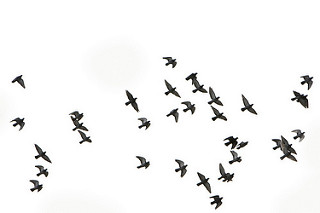
In stories old and new alike, real and imagined, people dream of taking flight. Though this illusion has metaphoric symbolism, the act of flying nonetheless intrigues humans. An act which birds accomplish not with the assistance of technology but through their very form. By examining the mechanisms and traits that enable a ‘birds eye view’, perhaps we can begin to understand why flying is sensational in lieu of the sensation of flying . . .
To begin, birds possess specialized bones, which facilitate flight. These bones are pneumatic or air-filled, a trait which was also common in some dinosaur species including the iconic Velociraptor and T. rex. [1] Lightweight bones allow for lift off. In addition, avian skeletons have fewer bones overall either through evolutionary loss or fusion [2]. Bone fusion transfers shock and stiffens the body of birds in flight thereby stabilizing them. Powerful muscles are also important for flying, especially for flapping flight. Unlike gliding, flapping flight requires constant up and down movement of wings accomplished by large pectoralis and supracoracoideus muscles.
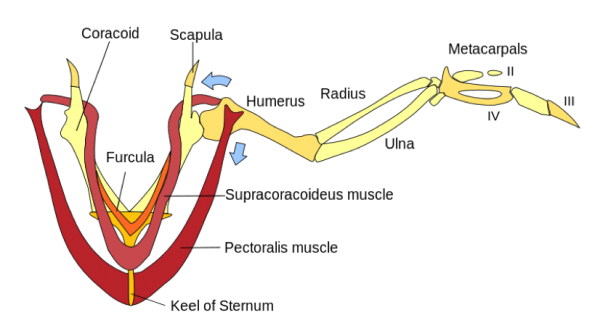
Of course, wings are also necessary for flying, but how do they work? Can this tool be recreated? In the sense of re-imagining and not duplicating, man-made ‘wings’ have already been invented and function in a similar fashion to bird wings. For each incarnation, bird or airplane, air moves above and below wings at different speed creating force at different angles. High pressure builds under the wing as opposed to over the wing creating lift. Similarly, thrust and drag are terms used to describe horizontal momentum and delay. Birds and pilots can adjust the angle of their wings relative to surrounding air to change directions.
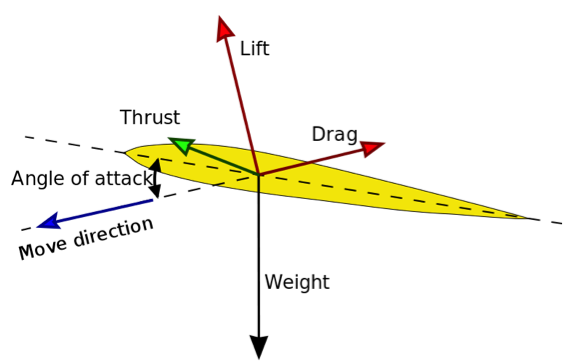
Though wonderfully beautiful in their variety, feathers do serve a functional purpose in relation to flying. The closing and separation of feathers allows less or more space for air to penetrate. For this reason, birds can incrementally change flight patterns between take off, gliding, flapping flight, and soaring*. Additionally, birds use wing and tail feathers to control speed and direction.[3] Please visit the Canadian Museum of Nature to watch and learn about different stages of flight.
Rather than removing the mystery, understanding the intricacies of flight only strengthens our sense of wonder. As individuals or amassed, poetry in motion.
*Only some birds have mastered soaring.
Further resources:
[1] http://www.ucmp.berkeley.edu/science/profiles/wedel_0609.php
[2] http://www.hsu.edu/pictures.aspx?id=1287
[3] http://wiki.answers.com/Q/How_do_birds_fly
Our eNews features information on exhibitions,
upcoming events, and subscriber-only special offers!
Sign Up for eNews